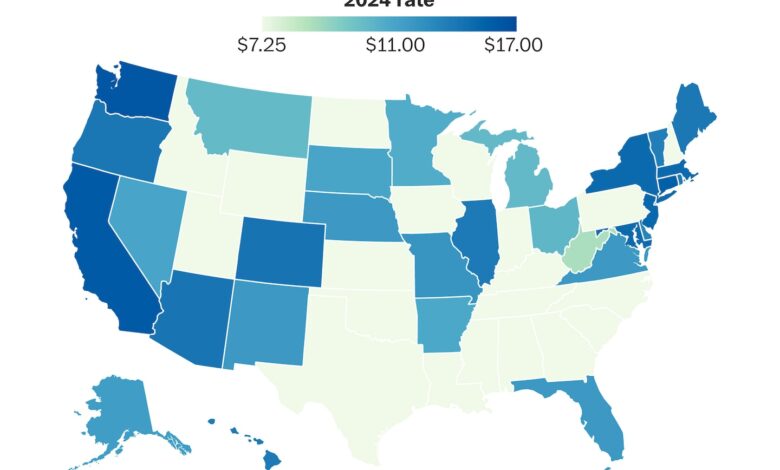Compare the 22 states that increased minimum wage in 2024

Twenty-two states increased their minimum wages in January
The EPI’s analysis found that women make up a majority of those receiving a wage increase, and that Black and Hispanic workers would disproportionately benefit from the pay raises. But raising the minimum wage directly affects a small part of the overall U.S. labor force — about 6 percent.
Because of the competitive job market in recent years, many workers are already being paid higher wages because employers boosted pay and benefits. The average hourly wage in the country was $34.10 in November, according to the Bureau of Labor Statistics (BLS), an increase of 4 percent over the past 12 months.
Even workers in the lower-paid retail industry have seen steadily increasing wages. The average retail wage was $23.86 per hour in November, according to BLS data.
Still, raising the minimum wage can help lock in some of those recent gains for workers across industries, said EPI senior economist Elise Gould.
“It creates a floor that wages can’t fall below,” even if the economy gets weaker in the future, she said.
Raising the minimum wage tends to be extremely popular with voters, both Democrats and Republicans. But many business groups and Republican lawmakers have opposed increases, saying it could force companies to cut jobs because they might not be able to absorb the higher costs. The Congressional Budget Office last month released an analysis estimating that raising the federal minimum wage to $17 an hour by 2029 would reduce poverty but also lead to the elimination of hundreds of thousands of jobs.
Although fewer people may directly gain from the 2024 minimum-wage increases, boosting the wage floors can benefit some of the country’s most vulnerable workers, especially as people grapple with cost-of-living increases that remain high. Inflation hit a high of 9.1 percent in 2022 but dropped to 3.1 percent in November — still higher than normal. A dozen states that boosted minimum wage this year have tied automatic annual increases to inflation, according to EPI, including Alaska, Montana and Vermont.
Though many states saw a bump, about 20 states still use the federal minimum wage of $7.25 per hour.
Maryland was one of the 22 states to increase its minimum wage this year, bumping it to $15 per hour. The change will benefit about 163,000 workers, according to the governor’s office. Wages in Virginia and D.C. remain unchanged this year, at $12 and $17, respectively — far above the federal minimum wage of $7.25, which is used in about 20 states.
Washington state’s January increase brings it to $16.28 per hour — the highest state minimum wage in the country. Many individual municipalities beat it out across the country, including Tukwila, Wash., which now has the highest minimum wage in the country, according to EPI. Workers at large employers in the city, just south of Seattle, will now make at least $20.29 per hour.
In recent years, many workers emboldened by the tight labor market and fed up with low wages have advocated for increased pay and benefits, sometimes banding together and forming unions and even striking.
More than a half-million workers walked off the job in 2023, according to Bloomberg Law’s database of work stoppages, making it one of the three biggest strike years since 1990, and the largest since the coronavirus pandemic.
State minimum wages may vary based on employer size, health-care availability and tipped wages. Some states do not have a minimum wage, or they have a minimum wage lower than the federal minimum. Those states’ minimum wages default to the federal minimum.
Editing by Karly Domb Sadof and Emily Eng.







